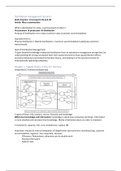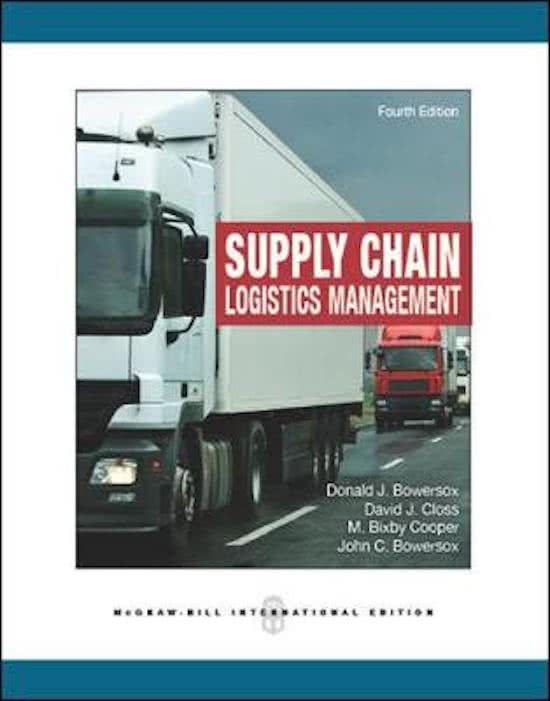Distribution management lecture 1
Book chapters: H1 (except 8-14) and H2
Article: Mass customization
What is distribution for some, is procurement of others!
Procurement à production à distribution
Purpose of distribution is to create customer value (customer accommodation)
Equivalent terms:
Physical distribution | Market distribution | Customer accommodation (satisfying customers’
wants/needs)
Goal of Distribution Management:
To gain detailed knowledge of physical distribution from an operations management perspective; by
understanding the strong conceptual basis from spatial economics (how space/distance affects
economic behaviour) and industrial location theory, and relating it to the practical context of
internationally operating companies.
Chapter 1: Supply Chains in the 21st Century
Integrated SC framework (Bowersox)
5 types of flows: info, product, service, financial and knowledge
Difference knowledge and information; knowledge is about how companies do things. Information
is more detailed and narrower than knowledge. Mainly information about an order or shipment.
5 Constraints: capacity, info, core competences, capital, HR
Important: enterprise internal integration of departments (procurement, manufacturing, customer
accommodation, logistics). Very important, because…
- Efficiency / Redundancy; otherwise you do double work
- Sharing information
- Reduce costs
,Integrated supply chains; need for systems thinking and total cost orientation.
A decrease of costs in 1 department, in most times will lead to an increase of costs in another
department. You have to look to an overall perspective. Main drivers to integrate within and
between companies; efficiency and to reduce the risk of bullwhip effect. Integration objectives:
• Responsiveness
• Variance reduction
• Inventory reduction
• Shipment consolidation (maximum loadfactor)
• Quality
• Lifecycle support
Integrated supply chain: role of (Information) Technology.
IT enabled companies to share information, in order to make better decisions (forecasts etc). We are
at the beginning of the fourth industrial revolution, based on cyber-physical systems (industry 4.0,
internet of things).
Towards an integrated SC; drivers and enablers
• Collaboration between companies
• Enterprise extension; integrating multiple companies
o Information sharing; through IT
o Process specialization; focus on core competences, outsource others.
• Integrated (Logistics) Service Providers (Integrators / LSPs): to achieve economies of scale,
reduce transportation costs. Everybody, including customers, will benefit. Increased
customer value! It’s the LSP’s core competence to provide logistic services at the highest
level and for the lowest cost. Others can focus on their core competences and outsource to
LSPs. They can do for example warehousing, transportation, VAS.
Core competence of German car manufacturers: designing cars and systems. Many suppliers,
outsourcing, assembling.
To summarize 1st part (ch 1)
• Integration: internal and external
• Costs trade-offs (reducing)
• Information Technology
,Assets; trucks etc.
VAS: packaging, pre-assembling, labeling etc
Orientation: coverage global vs regional.
3PL has more assets, 4PL is more focused on the coordination of everything.
In practice, many LSP’s are doing everything. They also outsource à one-stop solution
Responsive vs anticipatory business models: push vs pull.
Push (anticipatory): forecast and inventory inefficiencies.
Pull (responsive): IT makes it possible to have accurate, real-time information.
Postponement strategies
• Geographical/Logistics postponement: kind of push. Produce, ship, and store complete
products at a few strategic locations. When customer asks, you deliver. When very short
delivery times are needed. Example; airplane parts. If plane cannot fly, it costs much money.
High quality service.
• Manufacturing/Form postponement; products being manufactured one order at a time, no
preparatory work until customer specifications are known and purchase confirmation is
received. Pull (make to order, QRM). Maintain products in a non-customized status as long as
possible (standardize components)
Financial sophistication: applying time-based strategies should contribute to the overall value
creation.
Cash-to-Cash conversion (c2c): time required to convert material purchases into sales revenue. The
higher the inventory turn, the quicker the c2c conversion.
Dwell time: ratio of time an asset sits idle (being stored) to the time it is moving or otherwise
contributing to achieving sales/operational objectives. Measure for SC productivity.
Cash spin: benefits from reducing assets across a SC. Could be achieved through collaboration
All benefits from fast c2c conversion, dwell time reduction and cash spins contribute to an increase
of financial attractiveness of effective collaboration!!!
, CODP: Customer Order Decoupling Point
Mass-Customization: Is the production of personalized or customer-tailed goods in order to meet
the diverse and ever-changing customer preferences at almost mass production costs. The
postponement of logistics functions such as distribution, assembly, production until the latest
possible point in the supply network
Integrate and combine all different concepts:
Integration, cost tradeoffs, IT, postponement/mass customization, push/pull, LSP






